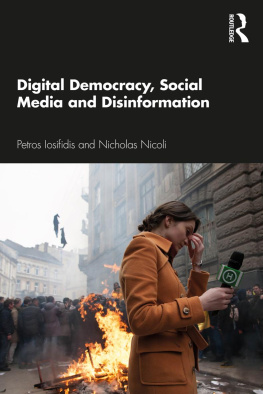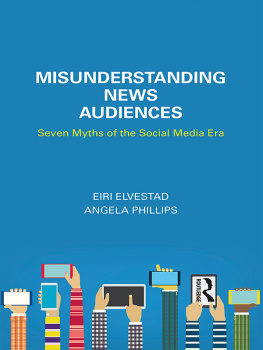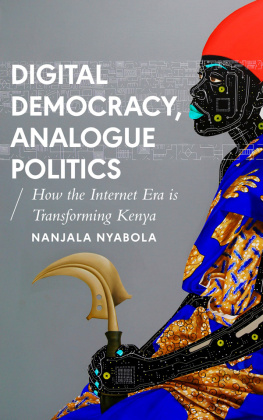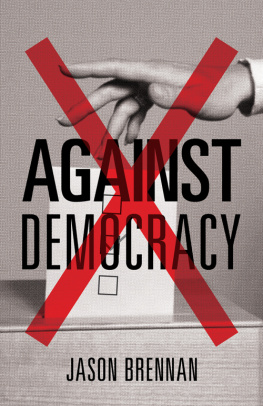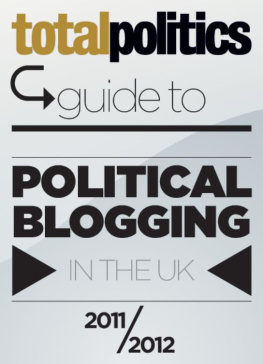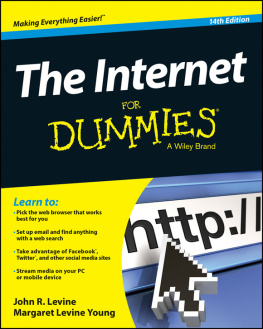
The Myth of Digital Democracy
The Myth of Digital Democracy
Matthew Hindman
PRINCETON UNIVERSITY PRESS Princeton and Oxford
Copyright 2009 by Princeton University Press
Published by Princeton University Press, 41 William Street, Princeton, New Jersey 08540
In the United Kingdom: Princeton University Press, 6 Oxford Street, Woodstock, Oxfordshire OX20 1TW
All Rights Reserved
Library of Congress Cataloging-in-Publication Data
Hindman, Matthew Scott, 1976
The myth of digital democracy / Matthew Hindman.
p. cm.
Includes bibliographical references.
ISBN 978-0-691-13761-2 (hardcover : alk. paper) ISBN 978-0-691-13868-8 (pbk. : alk. paper) 1. Political participationUnited States. 2. Internet in political campaignsUnited States. 3. InternetPolitical aspectsUnited States. I. Title.
JK1764.H56 2009
320.9730285'4678dc22
2008005147
British Library Cataloging-in-Publication Data is available
This book has been composed in Times Roman
Printed on acid-free paper.
press.princeton.edu
Printed in the United States of America
10 9 8 7 6 5 4 3 2 1
For Chuck, Karen, and Nathan
Contents
Illustrations
Figures
Tables
Acknowledgments
This book has been the work of many years, and the list of debts I have incurred in writing it is long. The earliest parts of The Myth of Digital Democracy began with my doctoral dissertation at Princeton University, supervised by Larry Bartels, Jennifer Hochshild, and Paul DiMaggio. This book would not exist without their stewardship of that thesis project and willingness to let me begin an untraditional line of research. Markus Prior, who later joined the project as the fourth reader, also provided many insights and critiques. My peers at Princeton were a continual source of helpful comments, and I am especially grateful to Chris Karpowitz, Rob Rodgers, Chris Mackie, Jonathan Ladd, and Gabriel Lenz.
Early work on this project benefited greatly from two years as a fellow at Harvard University, during which I was affiliated with both the Department of Government in the Graduate School of Arts and Sciences, and the National Center for Digital Government in the John F. Kennedy School of Government. While many in the government department and the visiting fellows program offered helpful advice, Daniel Ho, Francesca Gino, James Fowler, Kosuke Imai, and Alison Post deserve special thanks.
The National Center for Digital Government (NCDG) provided me with fellowship funding for my final year of graduate school, through National Science Foundation grant number 0131923. In directing the NCDG, Jane Fountain and David Lazer fostered a fertile academic environment, and both offered wise counsel. NCDG fellows Audrey Selian, Rajiv Shah, Maria Binz-Scharf, Ines Mergel, and Kenneth Neil Cukier helped refine this research too. Kenns contributions to the project as my office mate, editor, and sounding board were especially substantial.
Unusually for a political science project, this book depended at several junctures on corporate support. I am grateful to NEC Research Labs in Princeton, New Jersey, for lending its staff, software, and hardware, and to Gary Flake for setting up that arrangement. NEC researchers Kostas Tsioutsiouliklis and Judy A. Johnson, my collaborators on the Googlearchy research, were a pleasure to work with. The research presented here in would have been impossible without their expertise.
Hitwise Competitive Intelligence generously provided access to their treasure trove of Web usage data. Heather Hopkins, Bill Tancer, and the Hitwise support staff have my heartfelt thanks.
Other contributions also deserve recognition. Lada Adamic, at the time a member of Hewlett-Packards Web research group, supplied both data and helpful advice. The GUESS visualization software created by Eytan Adar, another member of the Hewlett-Packard Web research group, was used to create the Web maps in . Yuri Rapoport of Seaglex Software provided tools to help collect and analyze search engine results. Paul Jungwirth and Nathan Hindman helped me find and fix bugs in my own software code.
An earlier version of James McCann, Alan Abramowitz, the three anonymous reviewers, and the editorial staff of Perspectives all contributed to that portion of the book.
I am grateful to my colleagues at Arizona State University for their insights and support. Kim Fridkin, Pat Kenney, Colin Elman, Paul Goren, David Guston, Rudy Espino, and Merlyna Lim all offered important guidance. Several research assistants contributed to the book as well. Carol Lynn Bower and Risto Karinen provided help in coding user search queries, and Roland Maldonado helped conduct the blogger census. Anthony Hayes, an undergraduate honors student, was a particularly providential addition to the project. His smart and tireless work to map Web traffic went far beyond the call of duty.
In addition to all of those named above, I have been privileged to discuss portions of this work in many settings over many years with many smart people. While any listing of this group is sure to be incomplete, it does include (in no particular order) Eszter Hargittai, Bruce Bimber, Helen Nissenbaum, Bernardo Huberman, Albert-Lszl Barabsi, Paul Starr, Clay Shirky, Yochai Benkler, Eli Noam, Lance Bennett, Robert Pepper, Daniel Drezner, Paul Herrnson, Helen Margetts, Ralph Schroeder, Diana Owen, Joe Turow, Arthur Lupia, Gisella Sin, Ben Edelman, Richard Davis, and Cynthia Rudin. While not everyone in this group has shared my conclusions, each has shared insights that I have tried to incorporate into the text.
Lastly, I would like to thank my friends and family. The research presented here has spanned many transitions in my personal and professional life, and I am grateful beyond words for their unfailing love and support.
The Myth of Digital Democracy
One
The Internet and the Democratization of Politics
The world has arrived at an age of cheap complex devices of great reliability; and something is bound to come of it.
Vannevar Bush, As We May Think, July 1945
In March 1993, a group of college students at the University of Illinois posted a small piece of software onto the Internet. The program was called Mosaic, and it was the worlds first graphical Web browser. Prior to Mosaic, the World Wide Web, invented a few years previously by an English physicist working in Geneva, was but one of a number of applications that ran on top of the Internet. Mosaic changed everything. Unlike the cumbersome text-based programs that had preceded it, Mosaic made the Web a colorful and inviting medium that anyone could navigate. The Internet was soon transformed from a haven for techies and academics into the fastest-growing communications technology in history.
The release of Mosaic was the starting gun for the Internet revolution. Mosaic was quickly commercialized as the Netscape browser, and Netscapes public stock offering in 1995 ushered in the Internet stock market bubble. But almost from the moment that it became a mass medium, the Internet was seen as more than just a way to revamp commerce and the practice of business. Its most important promise, many loudly declared, was political. New sources of online information would make citizens more informed about politics. New forms of Internet organizing would help recruit previously inactive citizens into political participation. Cyberspace would become a robust forum for political debate. The openness of the Internet would allow citizens to compete with journalists for the creation and dissemination of political information.
Next page

